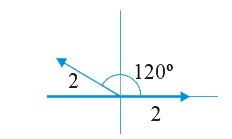(a) Write law of parallelogram of vector and obtain the expression for the resultant of two vectors acting in two different directions.
Step-by-Step Solution:
1. Definition: The law of parallelogram of vector addition states that if two vectors are represented as two adjacent sides of a parallelogram, then the resultant vector is represented by the diagonal of the parallelogram that passes through the common tail of the two vectors.
2. Arrangement of Vectors:
- Consider two vectors, →A and →B.
- Arrange these vectors such that their tails coincide at a single point.
3. Constructing the Parallelogram:
- Treat →A and →B as two adjacent sides of a parallelogram.
- Complete the parallelogram by drawing lines parallel to →A and →B from the head of each vector.
4. Resultant Vector:
- The diagonal of the parallelogram that starts from the common tail of →A and →B represents the resultant vector →R.
- The direction of →R is away from the common tail.
Part (b): Expression for the Resultant of Two Vectors
1. Vectors and Angle:
- Let the magnitudes of the vectors be A=|→A| and B=|→B|.
- Let the angle between the two vectors be θ.
2. Construct the Parallelogram:
- As before, complete the parallelogram with →A and →B as adjacent sides.
3. Using Right Triangle:
- Drop a perpendicular from the head of →B to the line extended from →A.
- This creates a right triangle where:
- The height (perpendicular) is Bsinθ.
- The base (adjacent side) is A+Bcosθ.
4. Applying Pythagorean Theorem:
- In the right triangle formed, apply the Pythagorean theorem:
R2=(A+Bcosθ)2+(Bsinθ)2
5. Expanding the Equation:
- Expand the equation:
R2=(A2+2ABcosθ+B2cos2θ)+(B2sin2θ)
6. Combining Terms:
- Combine B2cos2θ and B2sin2θ using the identity sin2θ+cos2θ=1:
R2=A2+B2+2ABcosθ
7. Final Result:
- Taking the square root gives the magnitude of the resultant vector:
R=√A2+B2+2ABcosθ
- Consider two vectors, →A and →B.
- Arrange these vectors such that their tails coincide at a single point.
- Treat →A and →B as two adjacent sides of a parallelogram.
- Complete the parallelogram by drawing lines parallel to →A and →B from the head of each vector.
- The diagonal of the parallelogram that starts from the common tail of →A and →B represents the resultant vector →R.
- The direction of →R is away from the common tail.
- Let the magnitudes of the vectors be A=|→A| and B=|→B|.
- Let the angle between the two vectors be θ.
- As before, complete the parallelogram with →A and →B as adjacent sides.
- Drop a perpendicular from the head of →B to the line extended from →A.
- This creates a right triangle where:
- The height (perpendicular) is Bsinθ.
- The base (adjacent side) is A+Bcosθ.
- In the right triangle formed, apply the Pythagorean theorem:
R2=(A+Bcosθ)2+(Bsinθ)2
- Expand the equation:
R2=(A2+2ABcosθ+B2cos2θ)+(B2sin2θ)
- Combine B2cos2θ and B2sin2θ using the identity sin2θ+cos2θ=1:
R2=A2+B2+2ABcosθ
- Taking the square root gives the magnitude of the resultant vector:
R=√A2+B2+2ABcosθ
Topper's Solved these Questions
- SELF ASSESSMENT PAPER 3BOOK - ICSECHAPTER - SELF ASSESSMENT PAPER 3EXERCISE - Section-C
9 Videos
- SELF ASSESSMENT PAPER 02BOOK - ICSECHAPTER - SELF ASSESSMENT PAPER 02EXERCISE - SECTION-D (Answer the following )
6 Videos
- SELF ASSESSMENT PAPER 4BOOK - ICSECHAPTER - SELF ASSESSMENT PAPER 4EXERCISE - Section-D
6 Videos
Similar Questions
Can the resultant of two vector be zero
View SolutionState parallelogram of law of vector addition .
View SolutionWrite the expression for the Lorentz force Fin vector form.
View SolutionHow can the resultant of 13 vectors acting at a point be found ?
View SolutionDefine vector product of two vectors.
View SolutionFind the magnitude and direction of the resultant of given vectors

View SolutionResultant of two vector of equal magnitude A is
View SolutionWrite two different vectors having same direction.
View SolutionWrite two different vectors having same direction.
View SolutionHow will you find the direction of the vector product of two vectors ?
View Solution
